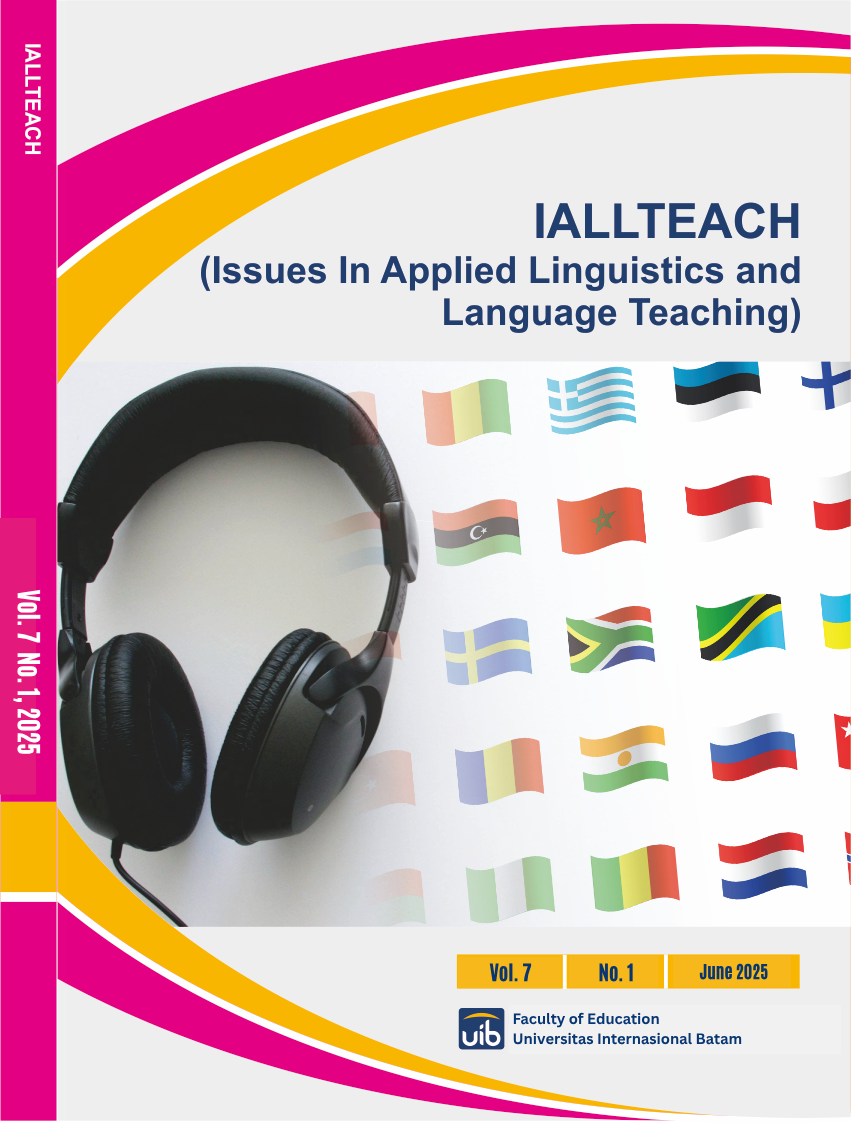Needs Analysis of English for Specific Purpose at Engineering Students in Vocational High School
DOI:
https://doi.org/10.37253/iallteach.v7i1.9333Keywords:
English for Specific Purposes (ESP), Need Analysis, Vocational High SchoolAbstract
English teaching for engineering students is categorized as English for Specific Purposes (ESP). This study aims to determine the English learning needs of the Electrical Power Installation Engineering, Industrial Automation Engineering, Building Modeling and Information Design, and Construction and Property Business departments at SMKN 3 Tanjungpinang. The research method used is descriptive qualitative with questionnaire and interview instruments involving 26 respondents, consisting of 25 students and 1 English teacher. The results of the study indicate that students need to improve their speaking skills, vocabulary, grammar, and pronunciation. Learning methods such as Contextual Teaching and Learning and Task-Based Learning need to be applied to support the learning process. The main difficulties faced are the lack of mastery of speaking and pronunciation, as well as limited vocabulary. Students also like video-based and interactive learning media. The implication is that teachers need to develop more communicative teaching methods and use interesting media so that learning is more effective and relevant to students' needs.
Downloads
References
Ayiz, A., & Hidayatulloh, A. (2024). The importance of vocabulary in teaching and learning in applied linguistics. Retrieved from https://www.researchgate.net/publication/359853011
Bakar, Z. A., & Abdullah, M. R. (2019). Importance of correct pronunciation in spoken English: Dimension of second language learners' perspective. Pertanika Journal of Social Sciences & Humanities, 27(1), 1–14.
Balasubramani, R., & Thim, R. (2020). Significance of English communication for engineering students. Retrieved from https://www.researchgate.net/publication/348593033
Browne, C. (2016). The New General Service List: Vocabulary for the 21st century. Retrieved from https://en.wikipedia.org/wiki/New_General_Service_List
(Note: While Wikipedia is not typically a scholarly source, the NGSL is a well-documented and updated tool developed by Charles Browne and colleagues. For academic use, refer to original papers hosted on: http://www.newgeneralservicelist.org/)
Celce-Murcia, M., Brinton, D. M., & Goodwin, J. M. (2010). Teaching pronunciation: A course book and reference guide (2nd ed.). Cambridge University Press.
Creswell, J. W. (2009). Research design: Qualitative, quantitative, and mixed method approaches. California: Sage Publications, Inc.
Engko, C., & Usmany, P. (2020). Dampak pandemi Covid-19 terhadap proses pembelajaran online. Jurnal Akuntansi, 6(1), 23–38. https://doi.org/10.30872/jfor.v24i4.11847
Harmer, J. (2007). The practice of English language teaching (4th ed.). Edinburgh Gate: Longman Pearson Education Ltd.
Hutchinson, T., & Waters, A. (1987). English for specific purposes. Cambridge University Press.
Indrasari, N. (2016). English for specific purposes: A need analysis at the second semester of physics education students of IAIN Raden Intan Lampung in the academic year of 2015/2016. Vol(9), 161–172.
Kim, E., Jeon, J.-J., Seo, H., & Kim, H. (2022). Automatic pronunciation assessment using self-supervised speech representation learning. arXiv. https://arxiv.org/abs/2204.03863
Kılıç, M. (2019). Vocabulary knowledge as a predictor of performance in writing and speaking: A case of Turkish EFL learners. PASAA: Journal of Language Teaching and Learning in Thailand, 57, 133–164.
Lightbown, P. M., & Spada, N. (2011). How languages are learned (2nd ed.). Oxford University Press.
Lopes, C. D. (2021). Role and importance of communication competence for engineering students. Retrieved from https://www.researchgate.net/publication/354649216
Mahbub, M. A., & Fauzi, F. A. (2018). Identifikasi kebutuhan bahasa Inggris siswa SMK TKJ melalui pendekatan analisis kebutuhan. Prosiding SNasPPM, 3(1), 116–121. http://prosiding.unirow.ac.id/index.php/SNasPPM/article/view/228
Moleong, L. (2007). Metode penelitian kualitatif. T. Remaja Rosda Karya.
Nurpahmi, S. (2017). An introduction to English for specific purpose. Alauddin University Press.
Nursahira, S. (2021). Analisa kebutuhan siswa dalam pelajaran bahasa Inggris di Sekolah Menengah Kejuruan 2 Pekanbaru: Perspektif siswa kelas XI (Skripsi thesis). Universitas Islam Negeri Sultan Syarif Kasim Riau.
Rackevičienė, S., Janulevičienė, V., & Mockienė, L. (2019). English for specific purposes and the second foreign language: Reaching beyond language training in philology study. The Journal of Teaching English for Specific and Academic Purposes, 7(2), 135–146.
Soni, M., & Thakur, J. S. (2018). A systematic review of automated grammar checking in English language. arXiv. https://arxiv.org/abs/1804.00540
Supiah Cahyati, S., Cynantia, R., & Rizkiani, S. (2015). Analisis kebutuhan siswa dalam materi buku teks bahasa Inggris tingkat SMK, Vol(2), 209–216. https://doi.org/10.22460/p2m.v2i2p209-216.180
Willis, D., & Willis, J. (2007). Melakukan pengajaran berbasis tugas. Oxford: Pers Universitas Oxford.
Willis, J. (1996). Kerangka pembelajaran berbasis tugas. Harlow: Pendidikan Longman Pearson.
Wu, J.-R., & Lou, Y.-G. (2018). Needs analysis of Chinese chemical engineering and technology undergraduate students in Yangtze University in English for specific purposes. Creative Education, 9(15), 2592–2603.
Yusran Pora. (2003). Enrich our vocabulary through reading and idioms. Yogyakarta: Pustaka Pelajar.




.png)






